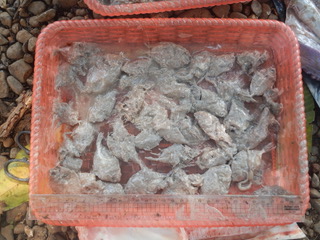“Love me some shrimp and crabs for dinner, with a side of fish”
Rhinorays, primarily giant guitarfish and wedgefish, as discovered in other locations, seem to enjoy the luxury of preying on shrimp and crabs in Karimunjawa National Park (KJNP) waters in Indonesia. Despite the fact they can grow up to 3 meters long, they seemed to enjoy small crustaceans more than other food available on the seafloor. The Elasmobranch Project Indonesia (EPI) found that one of the most abundant prey in the stomach of these rhinorays was an unidentified tiny shrimp species. Even though it was to be expected, it was still fascinating to learn that big fish like rhinorays, and with a big mouth to add, fancy these small shrimp. If we could have talked to the rhinorays, we would have said that the swimming crab (Portunus spp.) is bigger and better in taste. Still, perhaps the rhinorays have different taste buds compared to us humans.

Diet sample collection from rhinorays stomachs sourced from the Karimunjawa National Park waters. Photo © Ashma Hanifah
As the EPI team looked in the stomach of the rhinorays daily, we were used to the findings of the crustaceans which seemed as if they were served with a special greyish gravy sauce, which was a mix of sand and mud. The rhinorays are a group of bottom-dwelling fish. They love sandy and muddy habitats. For the guitarfish especially, their flatness and coloration, helped them to blend in these habitats. Most importantly, they are blessed with the ability to trap and suck their food a whole. And in these habitats, the sand and mud would have been inevitable as they got sucked as well into the stomach. Perhaps, their stomach is strong enough to pump out sand and mud swallowed as they do their ‘business’?

Swimming crab species (Portunus spp.) discovered as part of the diet of rhinorays species in Karimunjawa National Park waters. Photo © Luthfianto Hadi Nugroho
Though many have described it in their research, as other shark and ray species, the rhinorays in KJNP waters also consumed some fish. Small ones. At times, there would only be one fish, such as the lizardfish (Synodus spp.), but there was an occasion where one wedgefish had a massive amount of ponyfish (Leiognathus spp.). It was not surprising as they have been described to be able to hunt stingrays, therefore small fish were easier to ‘cook’. This finding further pointed out rhinorays ability to opportunistically hunt for food other than crustaceans when the chance arises.

Ponyfish species (Leiognathus spp.) discovered as part of the diet of rhinorays species in Karimunjawa National Park waters. Photo © Ashma Hanifah
However, some questions regarding their connection with other species in the ecosystem remain a mystery. What does the rhinorays control by consuming the crustaceans? What will happen if the rhinorays are gone from the waters? Will the ecosystem balance collapse? Will their presence or absence matter to the fishers then? What are their roles ecologically and why should fishers consider their presence important aside from their economic value? It could be possible that they have an important role in influencing the behaviour of the shrimp and crabs, as other ray species have shown. Science can help us to understand this to better protect them, and may we do so before they are truly gone forever.
